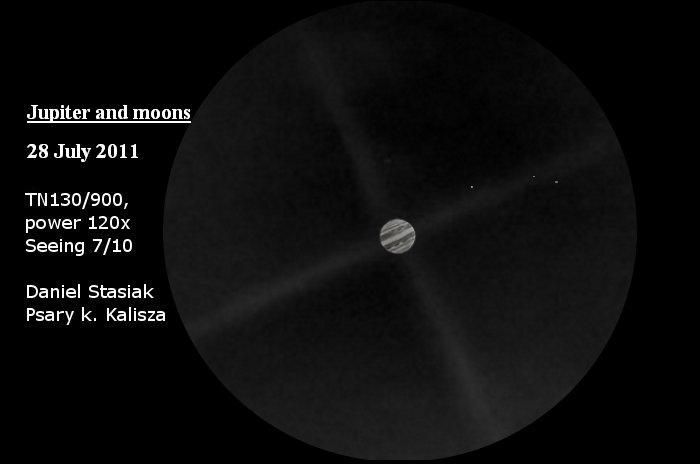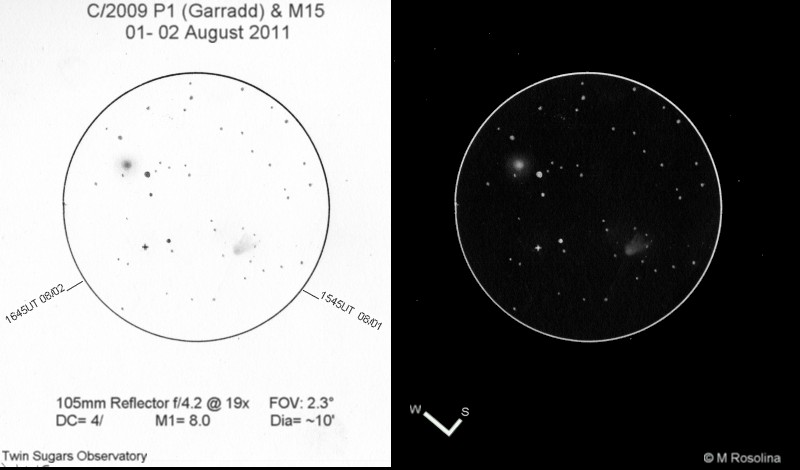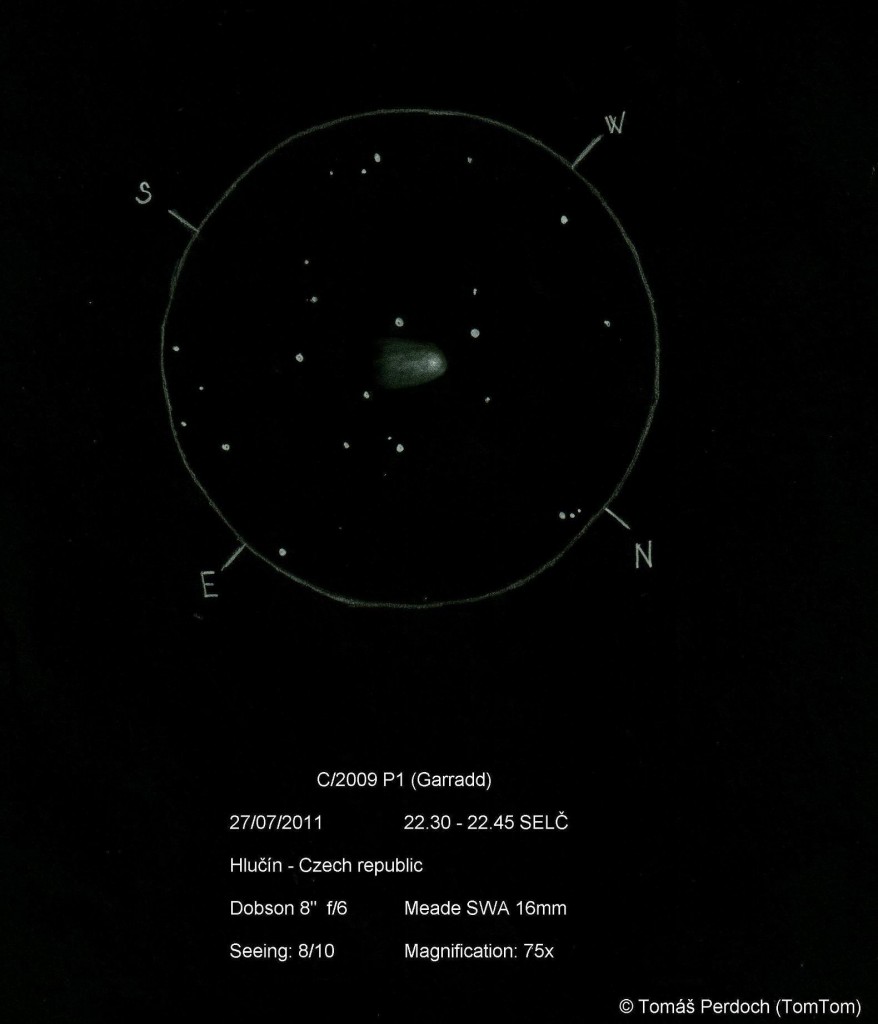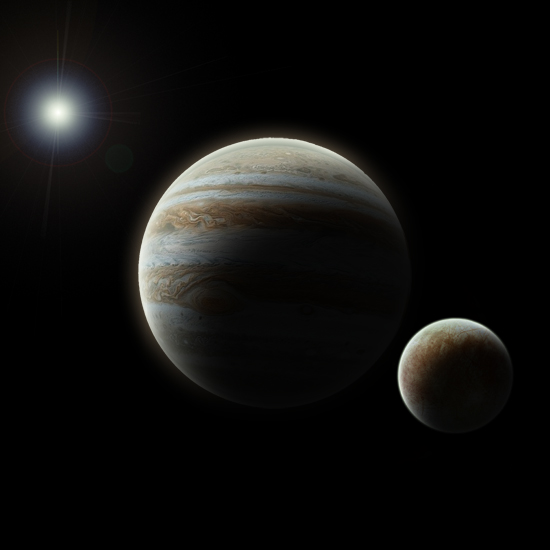
Location: Psary, Poland
Date: 28 July 2011
Media: Graphite pencil,white paper
Jupiter is my favorite planetary. Sketch was made using the Newtonian Telescope 130/900 which won thanks to obserwations of the planet. Seeing rate 7 / 10.

Hi,
The other night a visitor to the inner solar system, Comet C/2009 P1 (Garradd), appeared to make its own visit to M15, one of the brightest globular clusters in the northern sky. I say “appeared to” because M15 is actually over 33 thousand light years distant.
Comet Garradd was beautiful to see as it glided past the glob over the two nights I was able to view it. The soft glow of the moderately condensed comet head contrasted nicely with the bright knot of stars in M15 as the fan shaped tail swept faintly to the southeast, a sight I’ve tried to reproduce with this sketch.
Garradd will be making more visits over the next few weeks as it travels past the constellations Delphinus and Sagitta and the Coathanger asterism. Catch it if you are able!
C/2009 P1 (Garradd)
Comet
Twin Sugars Observatory Friars Hill, WV USA
August 1st & 2nd, 2011
Graphite pencils on white sketch paper, inverted digitally
Regards to all,
Michael Rosolina

Good morning,
I sketched Garradd last Wednesday. It is my first sketch of comet.
Garradd – Tom Perdoch
C/2009 P1 (Garradd)
Comet
Hlucin (CZ)
27/07/2011 _ 22.30 – 22.45
Pencil on white paper – inverted in Photoshop
It’s my first sketch of comet in my life. I saw this comet first time. I use Dobson 8″ and Meade 16mm SWA. It was first good night in July. I hope it won’t be the last sketch of this comet.

Object Type (Planet, moon)
Location (At Home)
Date (16-07-2011)
Media (Photoshop CS2)
Due to bad weather it is not possible for some time to observe the sky. That’s why I tried some in Photoshop.
It is a digital impression of Jupiter with Europa in the foreground.
It is my first try, hope you’ll like it.
—
Best regards,
Bert Schwertman
The Netherlands
Object Name: Saturn, Titan (T), Iapetus (J), Dione (D) and Rhea (R)
First Sketch:
CM1317,8º / CM2184,7º / CM3 319,1º
Rings: B = 10º
Location: Itajobi, SP, Brazil (backyard, downtown)
W49º03′ / S21º19′ / +460m
Date: December 27, 2010 – 06h30min (U.T.)
Seeing: 5/5 (Great!)
Telescope: reflecting 180mm / 1080mm (f6) dob mounted
Eyepieces: SP 32mm; SP 10mm; SP 6mm; 2,5x Barlow. No filter employed.
Media: graphite pencil on white paper, scanned then inverted and colors edited
Observer: Rodrigo Pasiani Costa
I spent that whole night observing the sky from backyard, and one of my targets was Saturn. Despite the clouds, the seeing and transparency were great, so I could see Saturn like never before (450x without any loss). Both the shadows of the rings on the globe and the shadows of the globe over the rings were clearly seen, splitting one another. The Cassini Division could be seen in both ends of the rings, but the difference in the outer ring color was not notable. A dark stripe crossed the planet, fading yet very remarkable. Another shy dark stripe intended to follow the first one, however was not able to cross the hole bright disc. Two of its moons were visible. In fact, Iapetus was probably visible too, however it was far away from the planet, and I missed it.
The next night it rained a lot, and I spent it doing something else. The following three nights the sky was clear again, and I could observe Saturn and its moons. I made this four sketches (in second picture) to show the dance of the moons around Saturn, all made at the same hour, during four days. Follow the sequence:
a) December 27, 2010
b) December 29, 2010
c) December 30, 2010
d) December 31, 2010
I hope you enjoy it, it was really pleasant to observe Saturn last summer.
Rodrigo Pasiani Costa
– Object Name: Jupiter
– Object Type: Planet
– Location: Lith, the Netherlands
– Date: 11-6-2011
– Media: pencil sketch on white paper
On March 5, 1979, Voyager 1 flew past Jupiter. During this passage, the probe made a series of legendary photographs of the planet.
Almost two years later, Voyager 1 flew past Saturn. After this passage, the probe began on its interstellar mission.
The sketch below is based on a photograph of Jupiter taken by Voyager 1. It is a pencil sketch, made on white paper.
Thanks for watching!
Rutger Teule
www.rutgerteule.com
Hey Artists!
It is now One year left to the last transit of Venus across the sun for this time!
It happens on the “wrong side” of the earth for us in Norway, but in northern Norway
we can see it low over horizon in the night (midnightsun).
I enjoyed the transit in 2004 in Greece. Info on my sketch! I used crayons and pencil.
Best wishes for this on “the other side”!!
Per-Jonny Bremseth.